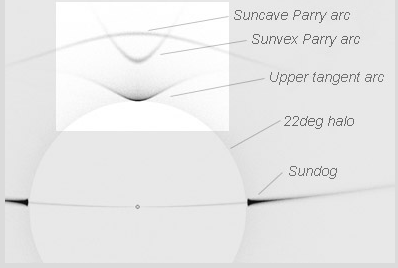Parry Arcs
Parry Arcs: A Rare and Spectacular Atmospheric Phenomenon
Parry arcs are a captivating and relatively uncommon atmospheric optical phenomenon that can be observed when the sun is less than 15° above the horizon. These arcs are named after the British Arctic explorer, Sir William Edward Parry, who first documented them during his expeditions in the early 19th century. While they may not be as well-known as other atmospheric optics phenomena like rainbows or halos, Parry arcs offer a unique and beautiful spectacle for those fortunate enough to witness them.
The Sunvex and Suncave Parry Arcs
One of the remarkable features of Parry arcs is the presence of two distinct arcs above the tangent arc. These are known as the sunvex and suncave Parry arcs. The sunvex arc, as the name suggests, appears convex towards the sun. It is best observed when the solar altitude ranges between 7° and 12°. The position of the sunvex arc relative to the suncave arc changes rapidly as the altitude of the sun varies.
A Rare Sight to Behold
Due to their specific viewing conditions, Parry arcs are considered rare sightings. Observers must be vigilant and patient, keeping a keen eye on the sky when the sun is low on the horizon. The combination of atmospheric conditions and ice crystals in the air creates the perfect environment for these arcs to form. When all the elements align, a breathtaking display of optical phenomena awaits.
Loren Hall's Artistic Depiction
One notable depiction of Parry arcs comes from artist Loren Hall, who captured their beauty on an early spring afternoon in 1991 in Rome, Georgia. Hall's artwork showcases the sunvex and suncave Parry arcs, offering a visual representation of these elusive atmospheric marvels. His portrayal not only highlights the intricate details of the arcs but also emphasizes the fleeting nature of this optical phenomenon.
The Enchanting Halo Display
Parry arcs often accompany other atmospheric optical phenomena, creating a mesmerizing display in the sky. The interaction of ice crystals, specifically singly oriented columns and plate crystals, can produce additional features such as supralateral arcs and colored circumzenithal arcs. These elements enhance the overall beauty and complexity of the halo display, adding an extra layer of fascination for observers.
Capturing Parry Arcs in Photographs
Photographing Parry arcs can be challenging due to their rarity and the specific conditions required for their formation. However, when successfully captured, these images serve as valuable documentation of this captivating phenomenon. Photographers who manage to seize the moment not only contribute to the scientific understanding of Parry arcs but also share their awe-inspiring images with the world, allowing others to appreciate their beauty.
A Glimpse into Atmospheric Optics
Parry arcs provide a unique glimpse into the fascinating world of atmospheric optics. Understanding how these arcs form requires knowledge of the intricate interplay between sunlight, ice crystals, and atmospheric conditions. Scientists and researchers continue to study these phenomena to unravel the mysteries of our atmosphere and gain insights into the complex processes that shape our visual experiences.
In conclusion, Parry arcs are a rare and captivating atmospheric optical phenomenon that grace the sky when the sun is low on the horizon. With their distinct sunvex and suncave arcs, they offer a unique visual spectacle for those fortunate enough to witness them. Through artwork, photography, and scientific exploration, we can appreciate and better understand the intricacies of these elusive phenomena. So, keep your eyes on the sky and embrace the wonder of Parry arcs when they reveal themselves in all their splendor.

Sunvex and suncave Parry arcs. When the sun is less than 15° high look out for the rare sight of two Parry arcs above the tangent arc.
The uncommon "sunvex" arc, so named because it is convex towards the sun, is best seen at solar altitudes of 7-12°. Its position relative to the suncave arc changes quickly as the sun's altitude alters.
Artist Loren Hall pictured the two arcs on an early spring afternoon in 1991 at Rome, Georgia.
The bright display also had a supralateral arc from singly oriented columns and plate crystals produced a coloured circumzenithal arc. The HaloSim simulation below matched the halos using a solar altitude of 11.7 °.
Photo ©Loren Hall, shown with permission.

Note: this article has been automatically converted from the old site and may not appear as intended. You can find the original article here.
Reference Atmospheric Optics
If you use any of the definitions, information, or data presented on Atmospheric Optics, please copy the link or reference below to properly credit us as the reference source. Thank you!
-
<a href="https://atoptics.co.uk/blog/parry-arcs-3/">Parry Arcs </a>
-
"Parry Arcs ". Atmospheric Optics. Accessed on November 14, 2024. https://atoptics.co.uk/blog/parry-arcs-3/.
-
"Parry Arcs ". Atmospheric Optics, https://atoptics.co.uk/blog/parry-arcs-3/. Accessed 14 November, 2024
-
Parry Arcs . Atmospheric Optics. Retrieved from https://atoptics.co.uk/blog/parry-arcs-3/.